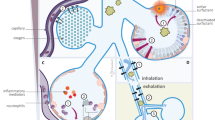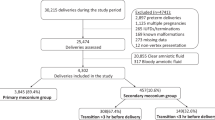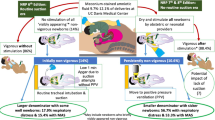Abstract
The meconium aspiration syndrome (MAS) is a common problem that continues to concern perinatologists and neonatologists. MAS is defined as respiratory distress in an infant born through meconium-stained amniotic fluid (MSAF) whose symptoms cannot be otherwise explained. This disorder may be life threatening, complicated by respiratory failure, pulmonary air leaks and persistent pulmonary hypertension. Approaches to the prevention of MAS have changed over time with collaboration between obstetricians and pediatricians forming the foundations for care. This report details the management of babies delivered with associated MSAF before the accumulation of evidence for best practice through appropriately powered, prospective randomized controlled trials.
This is a preview of subscription content, access via your institution
Access options
Subscribe to this journal
Receive 12 print issues and online access
$259.00 per year
only $21.58 per issue
Buy this article
- Purchase on Springer Link
- Instant access to full article PDF
Prices may be subject to local taxes which are calculated during checkout

Similar content being viewed by others
References
Abramovich DR, Gray ES . Physiologic fetal defecation in midpregnancy. Obstet Gynecol 1982; 60: 294.
Ramon Y, Cajal CL, Martinez RO . Defecation in utero: a physiologic fetal function. Am J Obstet Gynecol 2003; 188: 153.
Cleary GM, Wiswell TE . Meconium-stained amniotic fluid and the meconium aspiration syndrome: an update. Pediatr Clin North Am 1998; 45: 511–529.
Dargaville PA, Copnell B . The epidemiology of meconium aspiration syndrome: incidence, risk factors, therapies, and outcome. Pediatrics 2006; 117: 1712.
Yoder BA, Kirsch EA, Barth WH, Gordon MC . Changing obstetric practice associated with decreasing incidence of meconium aspiration syndrome. Obstet Gynecol 2002; 99: 731–739.
Murphy JD, Vawter GF, Reid LM . Pulmonary vascular disease in fatal meconium aspiration. J Pediatr 1984; 104: 758–762.
Gregory GA, Gooding CA, Phibbs RH, Tooley WH . Meconium aspiration in infants—a prospective study. J Pediatr 1974; 85: 848–852.
Ting P, Brady JP . Tracheal suction in meconium aspiration. Am J Obstet Gynecol 1975; 122: 767–771.
Carson B, Losey R, Bowes Jr WA, Simmons MA . Combined obstetric and pediatric approach to prevent meconium aspiration syndrome. Am J Obstet Gynecol 1976; 126: 712.
Yeh TF, Srinivasan G, Harris V, Pildes RS . Hydrocortisone therapy in meconium aspiration syndrome: a controlled study. J Pediatr 1977; 90: 140–143.
Fox WW, Gewitz MH, Dinwiddie R, Drummond WH, Peckham GJ . Pulmonary hypertension in the perinatal aspiration syndromes. Pediatrics 1977; 59: 205–211.
Bartlett RH, Gazzaniga AB, Huxtable RF, Schippers HC, O’Connor MJ, Jefferies MR . Extracorporeal circulation (ECMO) in neonatal respiratory failure. J Thorac Cardiovasc Surg 1977; 74: 826–833.
El Shahed AI, Dargaville P, Ohlsson A, Soll RF . Surfactant for meconium aspiration syndrome in full term/near term infants. Cochrane Database Syst Rev 2007: CD002054.
Greenough A, Pulikot A, Dimitriou G . Prevention and management of meconium aspiration syndrome—assessment of evidence based practice. Eur J Pediatr 2005; 164: 329–330.
Wiswell TE, Knight GR, Finer NN, Donn SM, Desai H, Walsh WF et al. A multicenter, randomized, controlled trial comparing surfaxin (lucinactant) lavage with standard care for treatment of meconium aspiration syndrome. Pediatrics 2002; 109: 1081–1087.
Nakamura T, Matsuzawa S, Sugiura M, Tamura M . A randomised control study of partial liquid ventilation after airway lavage with exogenous surfactant in a meconium aspiration syndrome animal model. Arch Dis Child Fetal Neonatal Ed 2000; 82: F160–F162.
Falciglia H . Failure to prevent meconium aspiration syndrome. Obstet Gynecol 1988; 71: 349–353.
Falciglia HS, Henderschott C, Potter P, Helmchen R . Does DeLee suction at the perineum prevent meconium aspiration syndrome? Am J Obstet Gynecol 1992; 167: 1243–1249.
Linder N, Aranda JV, Tsur M, Matoth I, Yatsiv I, Mandelberg H et al. Need for endotracheal intubation and suction in meconium-stained neonates. J Pediatr 1988; 112: 613–615.
Wiswell TE, Gannon CM, Jacob J, Goldsmith L, Szyld E, Weiss K et al. Delivery room management of the apparently vigorous meconium-stained neonate: results of the multicenter, international collaborative trial. Pediatrics 2000; 105 (1 Part 1): 1–7.
Halliday HL . Endotracheal intubation at birth for preventing morbidity and mortality in vigorous, meconium-stained infants born at term. Cochrane Database Syst Rev 2001: CD000500.
Vain NE, Szyld EG, Prudent LM, Wiswell TE, Aguilar AM, Vivas NI . Oropharyngeal and nasopharyngeal suctioning of meconium-stained neonates before delivery of their shoulders: multicentre, randomised controlled trial. Lancet 2004; 364: 597–602.
ACOG Committee Obstetric Practice. ACOG Committee Opinion Number 346, October 2006: amnioninfusion does not prevent meconium aspiration syndrome. Obstet Gynecol 2006; 108: 1053.
Fraser WD, Hofmeyr J, Lede R, Faron G, Alexander S, Goffinet F et al., Amnioinfusion Trial Group. Amnioinfusion for the prevention of the meconium aspiration syndrome. N Engl J Med 2005; 353: 909–917.
Ross MG . Meconium aspiration syndrome—more than intrapartum meconium. N Engl J Med 2005; 353: 946–948.
Xu H, Hofmeyr J, Roy C, Fraser WD . Intrapartum amnioinfusion for meconium-stained amniotic fluid: a systematicreview of randomised controlled trials. British J Obstet Gynecol 2007; 114: 383–390.
Marshall R, Tyrala E, McAlister W, Sheehan M . Meconium aspiration syndrome. Neonatal and follow up study. Am J Obstet Gynecol 1978; 131: 672–676.
Author information
Authors and Affiliations
Corresponding author
Additional information
Disclosure
Avroy Fanaroff has received consulting fees from NATUS.
Rights and permissions
About this article
Cite this article
Fanaroff, A. Meconium aspiration syndrome: historical aspects. J Perinatol 28 (Suppl 3), S3–S7 (2008). https://doi.org/10.1038/jp.2008.162
Published:
Issue Date:
DOI: https://doi.org/10.1038/jp.2008.162
This article is cited by
-
Neonatal outcomes of non-vigorous neonates with meconium-stained amniotic fluid before and after change in tracheal suctioning recommendation
Journal of Perinatology (2022)
-
Steroids for the Management of Neonates With Meconium Aspiration Syndrome: A Systematic Review and Meta-analysis
Indian Pediatrics (2021)
-
Meconium exposure and autism risk
Journal of Perinatology (2017)



